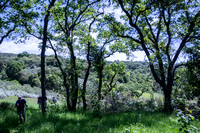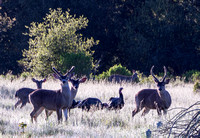Created 21-Apr-19
Entering the Main Gate well before the scheduled tour, I felt my mind move toward ease and my senses sharpen. There is nothing better than a quiet time at dawn, alone with my senses and my cameras – and the world.
I had thought I might walk down to the dam as usual, perhaps wait for the Canada Geese to leave with their usual racket, then perhaps wander around the lake. But a browsing deer looked out from behind a Coyote Brush, and I was pulled in that direction, “deciding” to hang out for a while with them and see what happened.
A little anticipatory stalking: I looped around the other side of the Sun Research Center and toward the Visitors’ Valley Oak near the parking lot, hoping to end up ahead of where the deer were drifting. Sure enough, there they were, grazing and browsing in the oak-studded field below the building. As far as I could see, this was a heard of bucks, in velvet. Grazing grass and browsing new oak leaves, they wandered and paused. Turkeys passed through, seemingly oblivious to the larger animals.
And this is how I ended up at the foot of the Visitors’ Valley Oak, in the first sunlight of the day. Swallows swooped about. Acorn Woodpeckers chased each other, showing off their skills in flight, then settled down to search the bark – for insects, I presume. There were other birds too – I leave it to my birder friends to leave comments with the IDs, thanks from all of us!
And the turkeys! Males, displaying, facing off. A neat head trick.
Finally I left the activity around the old oak and strolled down to the dam. The warm sun suffused the still air, promising peace. A few deep breaths, then time to head back to the parking lot to welcome the tour.
I had led a California Naturalist tour before; I was glad to see several old friends as leaders of the group and fellow Jasper Ridge docent tour leaders. Cal Nat is a wonderful program – check it out! Something like 8 weeks long, lots of teaching and learning, projects, a certificate. John Muir Laws had given them a workshop on nature journaling, so we made time for contemplation and journaling. It was nice to be able to relax and let people on the tour name the plants and enlighten each other; I was able to add my bits as well.
They had allotted 3 hours instead of the usual two-hour tour. Some of the other docents had ambitious goals for teaching as well as for covering ground. So I was able to relax and not worry too much about deadlines.
The tour was comprehensive. (Even so, we missed the creek, the riparian area, and the newt parade along Trail 3.) We crossed the dam and passed up through oak woodlands, full of Warrior’s Plume (Pedicularis densiflora), Buckeyes with fresh leaves, White Globe Lilies, fragrant Ceonothus, Yerba Santa in bloom, and more. Busy keeping the group moving (OK, so I was a little clock-driven), I took few good photos. We passed the former headquarters of the Shack Riders (AKA the Hillside Lab), admiring the Yerba Santa and other chaparral plants before entering the fertile oak woodlands again on Trail 7. Bush Lupines! Then into the forest of Blue Oaks, a little drier, but redolent with interesting flowers and plants, including “White” Globe Lilies in the sunlight, showing off their pink and yellow hair-filled pollinator sanctuaries. New leaves everywhere, tinted blue on the oaks.
What causes the sudden end of the forest and the start of the open grassland on the ridge? Maybe history plays a role. I have heard a rumor that the single-age Blue Oak forest grew after the workmen building Searsville Dam lived there in the 1880s, clearing the then forest for firewood and living space. (??? Is this true?) I have also heard there were orchards along the ridge, and later, cattle grazing. I do know that there are several different soil regimes on the ridge; you can see sudden straight lines crossing the grassland, marking the boundaries of different ecosystems, different kinds of grass -- culminating with serpentine soil and exposed serpentine rocks, the last refuge of many native flowering plants.
On to the serpentine grasslands! They were still at their peak. Goldfields, Owl’s-clover, Leptosiphon. Poppies, opened up in the warming sunlight. I even saw a few Tidy Tips for the first time this season – they seem quite scarce this year.
We did stop for our nature jounaling, spread out along the road, each in their own little world of grass, flowers, and insects.
Exploring down along Trail 10, we traversed grassland, woodland, chaparral, and a lovely Blue Oak copse, enjoying occasional distant views of the Western Hillsides. We found ourselves walking through a carpet of lupine, blossoming in blue and white, visited by heavy bumblebees, pulling down the tempting flowers as they landed.
Shade welcomed us as we walked Trail 12 down Corte Madera Creek, noting the flood plains from the recent rains. Lunch at the picnic tables. A nice day.
As the tour was breaking up, a hawk wheeled overhead and flew off around the lake. [A Sharp-shinned Hawk? Cooper’s?? Please leave an ID!] A Great Blue Heron flew westerly, perhaps toward the upper lake. The resident Pacific Rattlesnake dozed in the warm sun, in the end of its hollow log. Claire heard a persistent series of sharp squeaks, and didn’t think it was a bird. She finally pointed out a Ground Squirrel in the hollow of a Valley Oak nearby, raising the alarm. Funny, I don’t think the squirrel could even see the snake from there – but it was certainly warning everyone. The snake dozed on.
I had thought I might walk down to the dam as usual, perhaps wait for the Canada Geese to leave with their usual racket, then perhaps wander around the lake. But a browsing deer looked out from behind a Coyote Brush, and I was pulled in that direction, “deciding” to hang out for a while with them and see what happened.
A little anticipatory stalking: I looped around the other side of the Sun Research Center and toward the Visitors’ Valley Oak near the parking lot, hoping to end up ahead of where the deer were drifting. Sure enough, there they were, grazing and browsing in the oak-studded field below the building. As far as I could see, this was a heard of bucks, in velvet. Grazing grass and browsing new oak leaves, they wandered and paused. Turkeys passed through, seemingly oblivious to the larger animals.
And this is how I ended up at the foot of the Visitors’ Valley Oak, in the first sunlight of the day. Swallows swooped about. Acorn Woodpeckers chased each other, showing off their skills in flight, then settled down to search the bark – for insects, I presume. There were other birds too – I leave it to my birder friends to leave comments with the IDs, thanks from all of us!
And the turkeys! Males, displaying, facing off. A neat head trick.
Finally I left the activity around the old oak and strolled down to the dam. The warm sun suffused the still air, promising peace. A few deep breaths, then time to head back to the parking lot to welcome the tour.
I had led a California Naturalist tour before; I was glad to see several old friends as leaders of the group and fellow Jasper Ridge docent tour leaders. Cal Nat is a wonderful program – check it out! Something like 8 weeks long, lots of teaching and learning, projects, a certificate. John Muir Laws had given them a workshop on nature journaling, so we made time for contemplation and journaling. It was nice to be able to relax and let people on the tour name the plants and enlighten each other; I was able to add my bits as well.
They had allotted 3 hours instead of the usual two-hour tour. Some of the other docents had ambitious goals for teaching as well as for covering ground. So I was able to relax and not worry too much about deadlines.
The tour was comprehensive. (Even so, we missed the creek, the riparian area, and the newt parade along Trail 3.) We crossed the dam and passed up through oak woodlands, full of Warrior’s Plume (Pedicularis densiflora), Buckeyes with fresh leaves, White Globe Lilies, fragrant Ceonothus, Yerba Santa in bloom, and more. Busy keeping the group moving (OK, so I was a little clock-driven), I took few good photos. We passed the former headquarters of the Shack Riders (AKA the Hillside Lab), admiring the Yerba Santa and other chaparral plants before entering the fertile oak woodlands again on Trail 7. Bush Lupines! Then into the forest of Blue Oaks, a little drier, but redolent with interesting flowers and plants, including “White” Globe Lilies in the sunlight, showing off their pink and yellow hair-filled pollinator sanctuaries. New leaves everywhere, tinted blue on the oaks.
What causes the sudden end of the forest and the start of the open grassland on the ridge? Maybe history plays a role. I have heard a rumor that the single-age Blue Oak forest grew after the workmen building Searsville Dam lived there in the 1880s, clearing the then forest for firewood and living space. (??? Is this true?) I have also heard there were orchards along the ridge, and later, cattle grazing. I do know that there are several different soil regimes on the ridge; you can see sudden straight lines crossing the grassland, marking the boundaries of different ecosystems, different kinds of grass -- culminating with serpentine soil and exposed serpentine rocks, the last refuge of many native flowering plants.
On to the serpentine grasslands! They were still at their peak. Goldfields, Owl’s-clover, Leptosiphon. Poppies, opened up in the warming sunlight. I even saw a few Tidy Tips for the first time this season – they seem quite scarce this year.
We did stop for our nature jounaling, spread out along the road, each in their own little world of grass, flowers, and insects.
Exploring down along Trail 10, we traversed grassland, woodland, chaparral, and a lovely Blue Oak copse, enjoying occasional distant views of the Western Hillsides. We found ourselves walking through a carpet of lupine, blossoming in blue and white, visited by heavy bumblebees, pulling down the tempting flowers as they landed.
Shade welcomed us as we walked Trail 12 down Corte Madera Creek, noting the flood plains from the recent rains. Lunch at the picnic tables. A nice day.
As the tour was breaking up, a hawk wheeled overhead and flew off around the lake. [A Sharp-shinned Hawk? Cooper’s?? Please leave an ID!] A Great Blue Heron flew westerly, perhaps toward the upper lake. The resident Pacific Rattlesnake dozed in the warm sun, in the end of its hollow log. Claire heard a persistent series of sharp squeaks, and didn’t think it was a bird. She finally pointed out a Ground Squirrel in the hollow of a Valley Oak nearby, raising the alarm. Funny, I don’t think the squirrel could even see the snake from there – but it was certainly warning everyone. The snake dozed on.
4/13/2019 Grand Tour with California Naturalists
Visitors 40
64 photos
Created 22-Dec-23
Modified 22-Dec-23

Before and After the Tour: Deer with Turkeys; Birds in the Visitors’ Valley Oak
Visitors 25
58 photos
Created 22-Dec-23
Modified 22-Dec-23

Dan Quinn